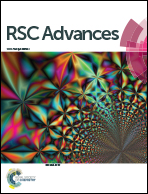Ultrasound-activated decafluoropentane-cored and chitosan-shelled nanodroplets for oxygen delivery to hypoxic cutaneous tissues†
Abstract
Ultrasound (US)-activated perfluoropentane-cored oxygen-loaded nanobubbles (OLNBs) were recently proposed as adjuvant therapeutic tools for pathologies of different etiology sharing hypoxia as a common feature (e.g. diabetes-associated chronic wounds, anaerobic infections, cancer). Here we introduce a new platform of oxygen nanocarriers, constituted of 2H,3H-decafluoropentane (DFP) as core fluorocarbon and chitosan as shell polysaccharide, and available either in liquid or gel formulations. Such oxygen-loaded nanodroplets (OLNDs) display spherical morphology, ∼700 nm diameters, cationic surfaces, good oxygen carrying capacity (without singlet oxygen generation after sterilization by ultraviolet-C rays), and no toxic effects on human keratinocytes. In vitro, OLNDs are more effective in releasing oxygen to hypoxic environments than former OLNBs, either with or without complementary US administration (f = 1 MHz; P = 5 W). In vivo, sonication of topically applied OLNDs appears essential to allow significant and time-sustained oxygen release. Taken together, the present data suggest that US-activated chitosan-shelled/DFP-cored OLNDs might be innovative, suitable and cost-effective devices to treat several hypoxia-associated pathologies of the cutaneous tissues.


 Please wait while we load your content...
Please wait while we load your content...